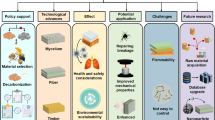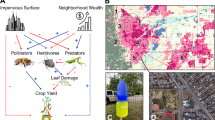Abstract
Mould growth on coated wood is today a genuine challenge for house owners. Environmentally sound wooden facades with long service lives and acceptable appearance are desired. The objective in this study was to investigate the accumulated mould growth on 13 different wood substrates with 3 surface coating systems by identifying the factors that contribute to the variation and to predict future performance. A generalized linear mixed model was fit to the data with the analysis showing that coating and exposure time both had highly significant influences on mould growth. Further, wood substrate was significant, but comparatively less than coating and exposure time. A smaller coefficient for mould coverage in the beginning of the exposure period gave the panels with one of the coating systems, BAP, a delay in mould growth, and the extrapolated values for years 6–12 indicate a longer aesthetic service life than panels with the two other coating systems. Coated heartwood as wood type was less susceptible to mould growth than coated mixed wood and coated sapwood. Acetylated pine as wood substrate and aspen as wood species had lower resistance to mould growth than the other wood substrates and wood species, respectively.



Similar content being viewed by others
References
Adan OCG (1994) On the fungal defacement of interior finishes. Thesis, Eindhoven University of Technology, Eindhoven, 223 p
Agresti A (2002) Categorical data analysis. Wiley series in probability and statistics. Wiley, Hoboken, 710 pp
Ahola P, Jämsä S, Viitanen H, Viitaniemi P (2002) Mould and blue stain on heat treated wood. Seminar on bio-deterioration of coated wood—coating and substrate. COST E18, VTT, 4–5 April 2002, Lisbon. http://virtual.vtt.fi/virtual/proj6/coste18/workshopproceedings.htm
Alfredsen G, Jacobsen B, Evans F (2008) Decking—surface and system treatments. In: Proceedings from the 4th meeting of the Nordic Baltic Network in wood material science and engineering (WSE), 13–14 November 2008, Riga, Latvia
Ananth CV, Kleinbaum DG (1997) Regression models for ordinal response: a review of methods and applications. Int J Epidemiol 26:1323–1333
Beckers EPJ, de Meijer M, Militz H, Stevens M (1994) Resistance of acetylated wood to basidiomycetes, soft rot and blue stain. IRG/WP 94-40021. The International Research Group on Wood Preservation, Stockholm
Bjurman J (1996) Growth of discolouring fungi on painted wood in relation to paint composition. In: Nussbaum R (Hrsg) Wood–paint–moisture, Nordic conference. 9610081 (I). Trätek, Stockholm, pp 92–98
Bjurman J, Herder C (1992) Susceptibility of painted wood to discolouring fungi—influence of binder, solvent and surfactant. IRG/WP 92-3714. The International Research Group on Wood Preservation, Stockholm
Boonstra MJ, Tjeerdsma BF, Groeneveld HAC (1998) Thermal modification of non-durable wood species. 1. The PLATO technology: thermal modification of wood. IRG/WP 98-40123. International Research Group on Wood Preservation, Stockholm
Boutelje J (1990) Increase in the content of nitrogenous compounds at lumber surfaces during drying and possible biological effects. Wood Sci Technol 24:191–200
Bravery AF (1988) Biodeterioration of paint—a state-of-the-art comment. In: Houghton D, Smith RN, Eggins HOW (eds) Biodeterioration. Elsevier Applied Science, London, pp 466–485
Brelid PL, Westin M (2007) Acetylated wood—results from long-term field tests. In: Proceedings from the European conference on wood modification 2007, pp 71–78
Brelid PL, Simonson R, Bergman Ö, Nilsson T (2000) Resistance of acetylated wood to biological degradation. Hols Roh Werkst 58:331–337
Brischke C, Bayerbach R, Rapp AO (2006) Decay-influencing factors: a basis for service life prediction of wood and wood-based products. Wood Mater Sci Eng 1(3 and 4):91–107
Eaton RA, Hale MDC (1993) Wood: decay, pests and protection. Chapman & Hall, London, 546 pp
Edlund M-L (2004) Durability of some alternatives to preservative treated wood. IRG/WP 04-30353. The International Research Group on Wood Preservation, Stockholm
EN 350-2 (1994) Durability of wood and wood based products. Natural durability of solid wood. Part 2. Guide to natural durability and treatability of selected wood species of importance in Europe. European Committee of Standardisation
EN 927-3 (2000) Paints and varnishes—coating materials and coating systems for exterior wood—part 3. Natural weathering test. European Committee for Standardization
Friendly M (2000) Visualizing categorical data. SAS Institute Inc., Cary, 436 pp
Gobakken LR, Jenssen KM (2007) Growth and succession of mould on commercial paint systems in two field sites. IRG/WP 07-30421. The International Research Group on Wood Protection, Stockholm
Gobakken LR, Westin M (2008) Surface mould growth on five modified wood substrates coated with three different coating systems when exposed outdoors. Int Biodeterior Biodegrad 62:397–402
Hukka A, Viitanen H (1999) A mathematical model of mould growth on wooden material. Wood Sci Technol 33:475–485
Jämsä S, Ahola P, Viitaniemi P (2000) Long-term natural weathering of coated ThermoWood. Pigment Resin Technol 29:68–74
Kamdem DP, Pizzi A, Jermannaud A (2002) Durability of heat-treated wood. Holz Roh Werkst 60:1–6
Lande S, Westin M, Schneider M (2004a) Properties of furfurylated wood. Scand J For Res 19:22–30
Lande S, Westin M, Schneider M (2004b) Eco-efficient wood protection. Furfurylated wood as alternative to traditional wood preservation. Manag Environ Qual Int J 15:529–540
Larsson P (1998) Acetylation of solid wood—wood properties and process development. PhD thesis, Department of Forest Products and Chemical Engineering, Chalmers University of Technology, Göteborg, Sweden
Molenberghs G, Verbeke G (2005) Models for discrete longitudinal data. Springer series in statistics. Springer, Berlin, 683 pp
Nienhuis JG, van der Velde B, Cobben WNH, Beckers EPJ (2003) Exterior durability of coatings on modified wood. In: Van Acer J, Hill C (eds) The first European conference on wood modification, 3–4 April 2003. Ghent University, Ghent, pp 203–206
Rapp AO, Sailer M (2000) Heat treatment in Germany. In: Proceeding of seminar: production and development of heat treated wood in Europe, November 2000, Helsinki, Stockholm, Oslo
Ritschkoff A-C, Viitanen H, Koskela K (2000) The response of building materials to the mould exposure at different humidity and temperature conditions. In: Proceedings of healthy buildings 2000 Finnish society of indoor air quality and climate (FiSIAQ), Espoo, Finland, vol 3, pp 317–322
Rowell RN, Simonson R, Tillman A-M (1985) A process for improving dimensional stability and biological resistance of lignocellulosic materials. European Patent 0213252
Sailer M, Rapp AO, Leithoff H (2000) Improved resistance of Scots pine and spruce by application of an oil-heat treatment. IRG/WP 00-40162. The International Research Group on Wood Preservation, Stockholm
SAS (2004) SAS/STAT 9.1 user’s guide. SAS Institute Inc., Cary
SAS (2006) The GLIMMIX procedure. SAS Institute Inc., Cary
Schabenberger O (1995) The use of ordinal response methodology in forestry. For Sci 41:321–336
Schabenberger O, Pierce FJ (2001) Contemporary statistical models for plant and soil sciences. CRC Press, Boca Raton
Scheffer TC, Cowling EB (1966) Natural resistance of wood to microbial deterioration. Annu Rev Phytopathol 4:147–168
Schneider MH (1995) New cell wall and cell lumen wood polymer composites. Wood Sci Technol 29:121–127
Sedlbauer K (2002) Prediction of mould fungus formation on the surface of and inside building components. Thesis, Holzkirchen, Germany, 155 p
Terziev N, Bjurman J, Boutelje J (1994) Mould growth at lumber surfaces of pine after kiln and air drying. IRG/WP 94-40033. The International Research Group on Wood Preservation, Stockholm
Theander O, Bjurman J, Boutelje J (1993) Increase in the content of low-molecular carbohydrates at lumber surfaces during drying and correlation with nitrogen content, yellowing and mould growth. Wood Sci Technol 27:381–389
USDA Forest Service (1999) Wood handbook: wood as an engineering material. General technical report FPL-GTR-113. Department of Agriculture, Forest Service, Forest Products Laboratory, Madison, WI, USA, 463 pp
Vernois M (2001) Heat treatment of wood in France—state of the art. In: Rapp AO (Hrsg) Review on heat treatment of wood. Proceedings of the special seminar on heat treatments, 9 February 2001. Office for Official Publications of the European Communities, Luxenbourg, Antibes, France, pp 35–42
Viitanen H (1997) Modelling the time factor in the development of mould fungi—effect of critical humidity and temperature conditions in pine and spruce sapwood. Holzforschung 51(1):6–14
Viitanen H (2001) Factors affecting mould growth on kiln dried wood. Cost Action E 15, advances in the drying of wood. In: Proceedings of the 3rd workshop on softwood drying to specific end uses, 11–13 June 2001, Helsinki, Finland
Viitanen H, Ahola P (1997a) Resistance of painted pine sapwood to mould fungi. Part 1. The effect of water-borne paints and fungicides on mould growth. IRG/WP 97-10234. The International Research Group on Wood Preservation, Stockholm
Viitanen H, Ahola P (1997b) Resistance of painted wood to mould fungi. Part 2. The effect of wood substrate and acrylate systems on mould growth. IRG/WP 97–10233. The International Research Group on Wood Preservation, Stockholm
Viitaniemi P, Ranta-Maunus A, Jämsä S, Ek P (1995) Method for processing of wood at elevated temperatures. VTT Publication, Espoo
Wakeling RN, Plackett DV, Cronshaw DR (1992) The susceptibility of acetylated Pinus radiata to mould and stain fungi. IRG/WP 92-1548. The International Research Group on Wood Preservation, Stockholm
Weissenborn P, Östberg G, Bardage S (2003) Fungal growth on exterior coatings for wood. In: Proceedings of the 17th SLF congress: future trends in coatings technology, Stockholm, Sweden, pp 117–125
Westin M, Nilsson T, Hadi YS (1998) Field performance of furfurylated alcohol treated wood. In: Proceedings: the fourth Pacific Rim bio-based composites symposium, 2–5 November 1998, Bangor, Indonesia, pp 305–312
Westin M, Rapp AO, Hadi YS, Nilsson T (2002) Field trials with mini-stakes. IRG/WP 02–20-20244. International Research Group of Wood Protection, Stockholm
Williams SR, Feist WC (1994) Effect of preweathering, surface roughness, and wood species on the performance of paint and stains (1993 FSCT annual meeting and paint industries’ show: convention wrap-up issue). J Coat Technol 66:109–120
Williams SR, Winandy JE, Feist WC (1987) Adhesion of paint to weathered wood. For Prod J 37:29–31
Williams RS, Jourdain C, Daisey GI, Springate RW (2000) Wood properties affecting finish service life. J Coat Technol 72:35–42
Yang DQ, Bisson MC (2004) Mold growth on various wall materials. In: Proceedings of the woodframe housing durability and disaster issues conference, Forest Products Society, Madison, WI, pp 183–189
Acknowledgments
We would like to thank Mats Westin, SP Technical Research Institute of Sweden, for setting up the experiment. Comments from Olav Høibø, Norwegian University of Life Sciences, Carol Clausen, USDA Forest Service, Forest Products Laboratory and R. Sam Williams, USDA Forest Service, Forest Products Laboratory are highly acknowledged. The study was funded by Norwegian Research Council.
Author information
Authors and Affiliations
Corresponding author
Rights and permissions
About this article
Cite this article
Gobakken, L.R., Lebow, P.K. Modelling mould growth on coated modified and unmodified wood substrates exposed outdoors. Wood Sci Technol 44, 315–333 (2010). https://doi.org/10.1007/s00226-009-0283-0
Received:
Published:
Issue Date:
DOI: https://doi.org/10.1007/s00226-009-0283-0




